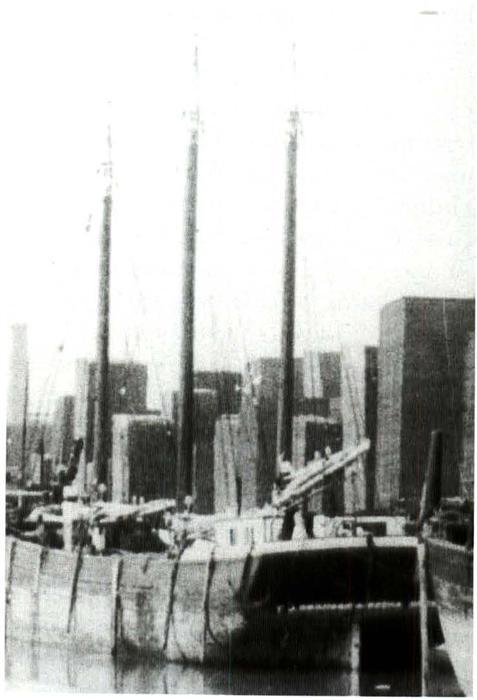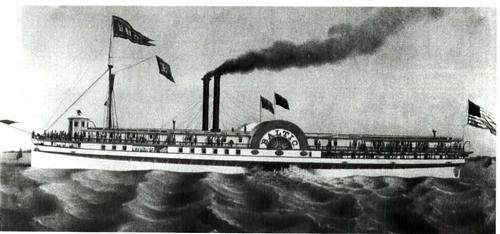Sign up for the Family Tree Newsletter Plus, you’ll receive our 10 Essential Genealogy Research Forms PDF as a special thank you!
Get Your Free Genealogy Forms
"*" indicates required fields
 Imagine a bustling 19th-century port city, its waterfront teeming with immigrants, sailors, merchants and dock workers. It’s a scene that could easily describe Boston, Baltimore — or Buffalo. After the Erie Canal opened in 1825, the Great Lakes became an avenue for immigrants on their way to a new life in the New World. These inland-seas immigrants were mostly Northern Europeans who, along with travelers from the East Coast, took the canal to Buffalo, where they’d catch a steamer and head west. Until the railroads began to take over in the 1860s, freight and passenger boats plied to and from almost every port on the Great Lakes.
Imagine a bustling 19th-century port city, its waterfront teeming with immigrants, sailors, merchants and dock workers. It’s a scene that could easily describe Boston, Baltimore — or Buffalo. After the Erie Canal opened in 1825, the Great Lakes became an avenue for immigrants on their way to a new life in the New World. These inland-seas immigrants were mostly Northern Europeans who, along with travelers from the East Coast, took the canal to Buffalo, where they’d catch a steamer and head west. Until the railroads began to take over in the 1860s, freight and passenger boats plied to and from almost every port on the Great Lakes.
Whether they went for business or pleasure, tracing your ancestors who sailed the Great Lakes can prove a challenge. Passenger lists are few and far between, while records of crew members, lighthouse keepers, lifesaving stations (forerunners of today’s Coast Guard) and others are scattered on both sides of the border. Fortunately, a growing number of Web sites can provide you with clues. Here are a few that can help keep your research afloat:
Downward Bound: Honoring Those Who Worked the Great Lakes
<www.mfhn.com/glsdb> Make Downward Bound your home port in the search for your Great Lakes ancestors. Part of the Michigan Gen Web project <www.rootsweb.com/~migenweb>, this searchable site offers some excellent starting points.
Three message boards of queries, biographies and obituaries allow you to post or read messages. All queries automatically get posted to the GLShips-L mailing list, which you can subscribe to on-site. Downward Bound’s resources consist of articles, portions of diaries, indexes of names from books, a bibliography of sources and an index of articles found in the journal Inland Seas, published by the Great Lakes Historical Society.
Was your ancestor a lake captain? Check out Captain’s Cabin, which has 10 photos you can click on to get biographical information. The Photo Gallery displays photos chiefly of the Middle Island, Mich., lifesaving station in Lake Erie. The site’s Research Addresses area provides contact info and links for museums, archives and organizations. A lengthy list of Great Lakes shipping links and information on how you can volunteer rounds out the site.
•Eastland Memorial Society
<www.inficad.com/~ksup>: Dedicated to the wreck of the Eastland, which sank in the Chicago River July 25,1915, killing more than 800 people.
• Great Lakes Historical Society
<www.inlandseas.org>: General information about the society, the museum and its collection at Vermillion, Ohio.
• Great Lakes Lighthouse Keepers Association
<gllkeepers.virtualave.net>: General information about the association dedicated to preserving lighthouse history.
Great Lakes Shipping Collection Database (University of Detroit)
<webpac.wayne.edu/webpac-bin/wgbroker?new+-access+top.udmship>: Searchable ship database that includes photos.
• Great Lakes Shipwreck Research
<www.execpc.com/~bbaillod>: Portal with lots of links to Great Lakes-related sites.
Maritime History of the Great Lakes
<www.hhpl.on.ca/GreatLakes> Maintained by Canadian Great Lakes marine historian Walter Lewis, this site strives to be an online archive of Great Lakes history — and it does an excellent job. This is the site where you’re most likely to find out if your great-greatgrandfather was a shipwright in Oswego, Ontario, or whether your third great-grandparents were shipwrecked on Lake Huron.
Start with the huge searchable database of visitor-contributed newspaper articles covering the late 18th to early 20th centuries. The articles come from the newspapers of lakeside cities, including Buffalo, Cleveland and Detroit on the US side, and Kingston, Oswego and St. Catharines, Ontario, on Canadian shores. Then go to Ship Lists, which contains period lists and registers such as the 1864 Register Of The Ships Of The Lakes And River St. Lawrence and the 1897 Blue Book Of American Shipping. The Blue Book is of special interest to genealogists — in addition to lists of ships, you’ll find sources such as Yacht Owners of The United States and Names and Addresses of Marine Engineers of Coasts and Rivers.
Other sections include Shipwrecks (an 1854 casualty list and links to online sites), Historical Documents (scanned books and reports, with links to appropriate documents on the University of Michigan’s Making Of America site <moa.umdl.umich.edu>), Articles (relating to Great Lakes history) and Research Collections (a compilation of links).

Marine Museum of the Great Lakes at Kingston
Planning a trip to this museum at Kingston, Ontario, or just want to see if its collections contain any useful resources for your search? Visit the museum virtually at its Web site. From the home page, click on Research for an overview of the museum’s collection, including advice on doing research there. Links on the page take you to the museum’s archives and collection catalogs. The Web site also has two searchable ship lists and a searchable database of Canadian ship registers.
Historical Collections of the Great Lakes
<www.bgsu.edu/colleges/library/hcgl>
HCGL is a descriptive online catalog of Bowling Green State University’s collections, similar to the Kingston Marine Museum site (above). The Manuscript and Archival Materials collection area, which is particularly detailed (be sure to click on the list of processed collections), contains the items of most interest to genealogists, such as personal papers, company records and detailed records of individual ships. And many images from HCGL’s extensive collection of Great Lakes ships are accessible through its Great Lakes Vessels Online Image Database. This collection is searchable and contains information on each ship. Even if the ship’s photo hasn’t been digitized, you can still get some basic information about it.
Great Lakes History Homepage
<greatlakeshistory.homestead.com/home.html>
Here Dave Swayze, an American Great Lakes marine historian, maintains a searchable database of every known shipwreck in the Great Lakes. Only general information on each wreck is provided, including the builder, owner and official number. It’s updated periodically. Swayze’s site has a few historical photos, links to other research sites and a crossword puzzle to help you brush up on Great Lakes history. You can also subscribe to a mailing list to receive transcriptions of marine-related clippings from 19th-century Detroit newspapers.
A Chronology Of Lake Navigation
<www.nmu.edu/upstudies/UPinfo/UPMarit/CHRONO.htm>
A Chronology of Lake Navigation gives you a rundown on Great Lakes maritime history from 1535, when Jacques Carrier first sailed up the St. Lawrence River, to 1983, when the last manned lighthouse on the Great Lakes was automated. This one-page, text-only site is the perfect place to help you put your family in context and give you clues about where to search for your Great Lakes ancestor.
From the June 2002 issue of Family Tree Magazine
ADVERTISEMENT




